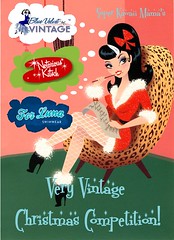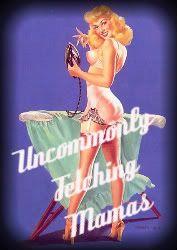A Series on Vintage - Part 2
Before I begin my pontificating on this topic, let me say that the (non monetary) value of a garment is generally in the eye of the beholder. As the saying goes, one man’s trash is another man’s treasure, which is the very reason we are having this discussion. So aside from the personal worth you see in your chosen garment, just how do you find a gem amongst the rows of dross?
Many people are simply after labels to validate the importance of their finds. And while this is a shorthand way to find an item of quality manufacture, it leaves a little more bargain hunting room for those of us with a little more savvy. Clearly if an item is carrying a Chanel label, it is highly likely to have retained its value. But what about those quality labels you aren’t familiar with?
Look for garments with the designer label in a woven tape as opposed to printed. The better the quality the garment, the more likely it is to have one of these sewn into the collar. While you are on a label hunt, look also along the inside side seams for tags stating the fabrics composition, this is where you will discover that your jacket is either the cashmere you have been lusting after, or a poor acrylic imitation.
Any garment that is lined shows more time and effort it its original manufacture. But not all linings are created equal. When you try on the garment, it should slide on and fit like a glove. There should be no pulling or puckering where the lining meets the body fabric. The lining should be oversized and not restrict your movement.
One of my pet hates with many new items is their poor seaming. Hanging threads, buttons that pop off on first wear and stitching that isn’t even tied off. In a quality vintage piece you’ll be looking for French seaming, (where all you see on the inside is a little flap of fabric that houses the seam) or seams that are bound in tape or some other form of binding. You may also come across flat seams that, in a time before overlocking machines, were created by zigzag stitches on the edges of the fabric, which are then turned over and straight stitched to prevent any fraying.
Buttons, zippers and fasteners can also tell you much about a garments quality. Any buttons made of natural materials like bone, wood or mother of pearl are more expensive for the manufacturer to buy, hence they indicate a higher quality garment. Buttons that are covered in the same fabric as the garment are also quite lovely and worth a look. As for zippers, their insertion gives you a clue to quality or not. In a better piece, the zipper will have a flap of fabric behind it to protect your skin from touching the teeth. The zip should also not be exposed (unless this is a design feature), and definitely not have any puckers or sag. A hook and eye fastening at the top of a zipper is also common on good vintage garments as opposed to those only masquerading as such.
And on the accessories front look for:
- · Scarves with hand rolled edges
- · Handbags that are lined and with stitched in woven labels. Unless you are into shabby chic stay away from any bags with rust on the closures or straps as this only gets worse with time and re platting is very expensive.
- · Shoes with good interior support and padding, and of natural materials.
- · Hats with their embellishments stitched in not glued, flowers made of silk, not plastic, as well as matching lining and band trim. As for labels look for woven labels again or often satin labels under clear vinyl in men’s hats.
This is a shorthanded guide to picking your gems here. The more knowledge you can acquire the better, but of course that takes time and a dedication that we don’t all have. But finding a piece of quality is only part of the story to finding your perfect vintage outfit. Next time I’ll tell you a little more about fit, and how to rescue those darlings that need a bit of TLC before they can make the transition to your wardrobe. And remember, all these things being said, if the colour just isn’t you or your passion is more luke warm than red hot, leave it behind and keep looking. You never know what might be around the corner and you’d hate to have done your dough by the time you find it.












14 comments:
Yay thanks SKM - I'm going thrifting this weekend!!
great advice. i need to go vintage shopping sooon. never experienced it. *cries*
This is a great little primer!
Another great thing to do is go to your local quality fabric store and familiarise yourself with the way that different fabrics look and feel - that way you can learn to pick silk from synthetic, wool from acrylic, cashmere by touch etc because vintage garments rarely have any fabric content labels.
Good advice! I've been vintage shopping for years, and find that these tried and true tips are always a good ruler to use for any second-hand purchase. :)
Thanks a lot for the advice, now I don't have any excuse not to go vintage shopping!
I have been known to rip out the lining and put in new lining, because sometimes the garment fits perfect but the lining is snug, I have never been able to figure that one out.
Great advice, thanks!
With handbags a good thing to do as well is to have a really good sniff of the interior (it looks so dodgy but it is necessary). Any mustiness or bad smells will only get worse with use/
Thank you for all this great information. It was almost all new to me. The only thing I already knew about was to look for woven, not printed labels.
You really know your stuff, SKM.
a dreamer: Make sure to take along a friend who has done it before and it will makes things much easier.
Skye:Absolutely. I think this is a trick for the more advanced hunter as it seems many peoples fingers are easily fooled. I've kept the tips easy for everyone this time, but I know you are an expert as evidence by that AMAZING 1930's dress find. I'm still thinking about that one.
Heather: Yep, it's the cheaper garments you'll have this problem with. What a lot of work to replace a lining, you must have loved them.
Floraposte: You'd be surprised what you can remedy with the right tricks. I'll cover these things in the next installment.
enc: Until the internet, I always thought I was a font of somewhat useless information. It's nice to have people who are actually interested in all this chatter.
Over the years I can't begin to tell you how many second hand garments I've bought because 'i might wear it one day'. At one point my wardrobe resembled a Savers storage facility. Needless to say I've refined my eye.
Brilliant! Thanks so much for this post SKM. As the others have said, you really know your stuff!
I'm completely with you on the annoyance of seams on new items - I often feel like I'm channelling my grandmother when I go shopping with friends and exclaim, "You can't buy that! There are threads hanging all over it!!!"
(As an aside - I really like when you "pontificate" - you do it well! ;-)
Wonderful post, so informative!
We must think alike, an episode I'm working on is about how to shop vintage- true vintage!
LM
x
Handy post! I didn't know about woven labels, though it does make sense.
(I am looking forward to the adjusting to fit info – there is a vintage [not yet completely investiigated, mind] soft velvet dress near home that could either be lovely, like something in stella maccartney's current collection, OR make me look like a big pillow.
I love that top illustration (is it a print?) so nice.
Post a Comment